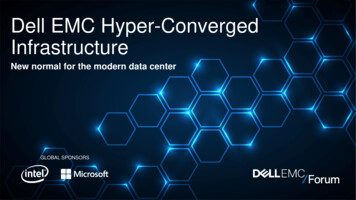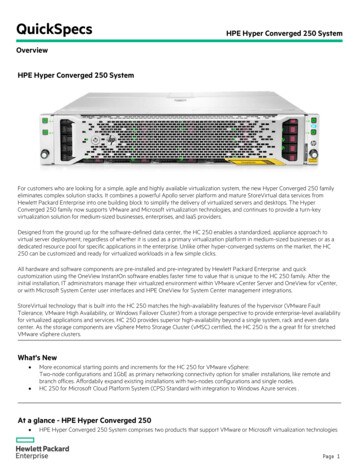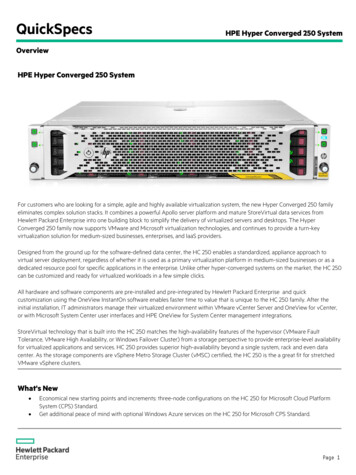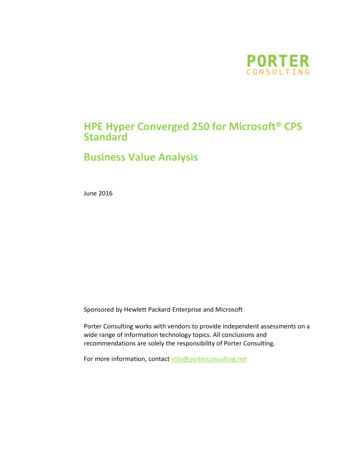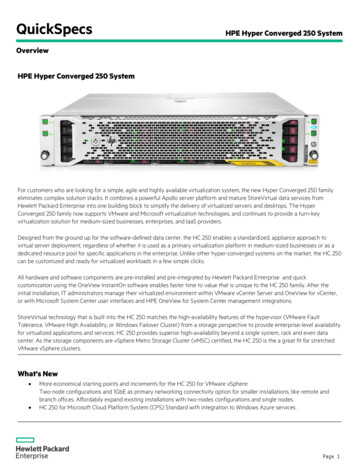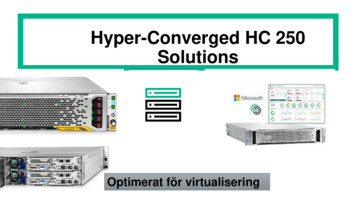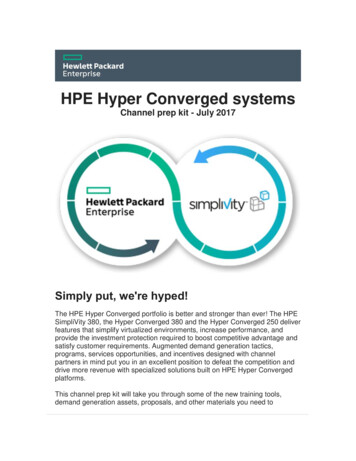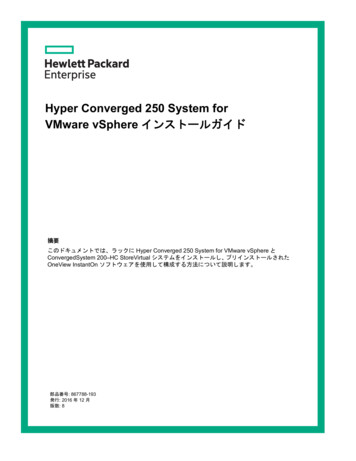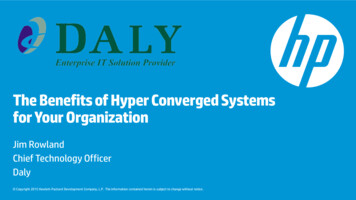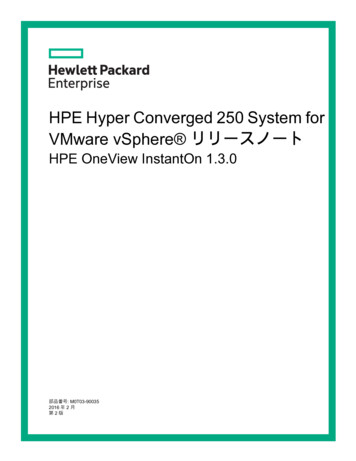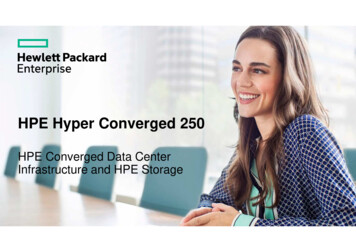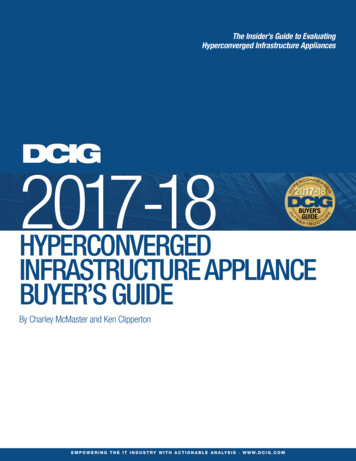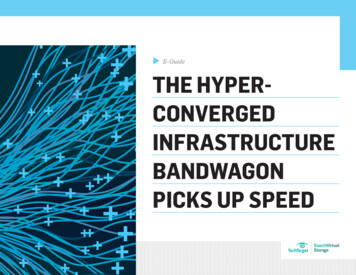
Transcription
E-GuideTHE HYPERCONVERGEDINFRASTRUCTUREBANDWAGONPICKS UP SPEEDSearchVirtualStorage
THE HYPER-CONVERGED INFRASTRUCTURE BANDWAGON PICKS UP SPEEDHomeThe hyper-convergedinfrastructurebandwagon picks upspeedHquicklygaining attention -- and sales -- becausethey offer many advantages over traditional storage products.yper - converged systems arePA G E 2 O F 8
THE HYPER-CONVERGED INFRASTRUCTURE BANDWAGON PICKS UP SPEEDTHE HYPER-CONVERGED INFRASTRUCTURE BANDWAGONPICKS UP SPEEDHomeThe hyper-convergedinfrastructurebandwagon picks upspeedJeff KatoOver the past year, I’ve interviewed numerous users and asked them why theychose hyper-converged products rather than more traditional data center gear.The users I’ve spoken with are extremely satisfied with their choices.When Taneja Group coined the term hyper-convergence in 2012, we defined it as a genuine integration of compute, networking, storage and servervirtualization delivered using a modular scale-out approach. These productsalso included advanced data services such as deduplication, compression,WAN optimization, storage virtualization and data protection, each deliveredwith a virtual machine (VM)-centric approach.The original hyper-converged infrastructure pioneers included Nutanix, Scale Computing and SimpliVity. They’ve since been joined by many others,including most major system vendors. VMware distributes EVO:RAIL throughmultiple system suppliers. Dell offers both an EVO:RAIL and a Nutanixbased product. Hewlett-Packard has an EVO:RAIL offering in addition to itsPA G E 3 O F 8
THE HYPER-CONVERGED INFRASTRUCTURE BANDWAGON PICKS UP SPEEDStoreVirtual VSA.DataCore Software, Gridstore and Maxta also have hyperconverged products and reference solutions.HomeThe hyper-convergedinfrastructurebandwagon picks upspeedKEY HIGHLIGHTS OF HYPER-CONVERGED ARCHITECTURESCores galore. I won’t quote the latest maximum core count in an x86 processor because the number will have changed by the time you read this. A CPUwith 12 cores is mainstream and that number is increasing fast. This mattersfor hyper-converged products because it allows more infrastructure serviceslike software-defined storage to coexist in the same CPU complex as businessapplications without diminishing the overall quality of service.Flash-first architectures. Vendors have taken advantage of the cost/performance improvements enabled by flash-based storage technologies by designing flash-first architectures into their software-defined storage technology.This, in turn, allows advanced data services such as deduplication, compression and WAN optimization to be added without significantly compromisingperformance. Flash accelerationalso enables scale-out storage architectures tooutperform legacy spinning disk arrays. So, hyper-converged systems can support a wider range of business application workloads in a smaller form-factor.Hyper-scale compute platforms. Hyper-scale optimized serversPA G E 4 O F 8
THE HYPER-CONVERGED INFRASTRUCTURE BANDWAGON PICKS UP SPEEDHomeThe hyper-convergedinfrastructurebandwagon picks upspeedare used at Google and Facebook, so why shouldn’t they also be used in onpremises data centers? Typically, the server of choice for many hyper-converged infrastructure products is a four-bladed 2U platform with 24 2.5-inchform-factor drive slots. This is an ideal configuration because the basic threenodes considered the typical starting point for most scale-out solutions canbe achieved in an extremely dense package. With two CPUs per blade, you caneasily support close to 100 cores in a 2U server chassis -- more than enough tosupport upwards of 50-plus VMs.WHY USERS ARE CHOOSING HYPER-CONVERGENCEIn my interviews with users, I found many factors contributed to their decisionto go with hyper-converged products.Simplicity. Some users of hyper-converged products were fed up withthe DIY approach to other products and the administrative expertise required.Typically, these users had limited administrative resources. They didn’t wantto manage storage complexity and desired simple dashboards to show howthey were doing with CPU, memory and storage utilization rates. They appreciated that data services were done at the VM level and that problem diagnosiswas done in a similar manner. Some opted to avoid advanced virtualizationPA G E 5 O F 8
THE HYPER-CONVERGED INFRASTRUCTURE BANDWAGON PICKS UP SPEEDHomeThe hyper-convergedinfrastructurebandwagon picks upspeedtechnology completely and chose a simple, completely encapsulated virtualized platform like Scale Computing’s HC3.Value. Hyper-converged users did their homework on TCO. Often, thesecompanies were comparing the option of moving services off-premises to thecloud vs. an on-premises DIY approach, so more staff is the last thing theywanted. When vendor price quotes came in, hyper-converged products easilybeat the DIY three-tier options in terms of capital acquisition costs. Considering the cloud option, these users were not yet comfortable with moving theirmission-critical applications to the cloud. So a solution that was just as easyas a public cloud deployment but with on-premises control and security wasappealing.Support experience. While support might not be what initially led usersto hyper-converged products, it will be what keeps them there for the long haul.The support mantra of “one throat to choke” is a hallmark of convergence. Users were very happy with their support experiences, as they only have to callone company for help.Availability and scalability. Users appreciated the built-in availabilityand scalability offered by their hyper-converged products. Most reported zerodowntime with systems; with high availability (HA) built in they don’t havePA G E 6 O F 8
THE HYPER-CONVERGED INFRASTRUCTURE BANDWAGON PICKS UP SPEEDHomeThe hyper-convergedinfrastructurebandwagon picks upspeedto design a multi-server, externally shared storage architecture. They also appreciated the simplicity of the designs; they bought just what they needed andcould upgrade modularly in small increments. Some larger users have evenadopted a node-level field-replaceable strategy where if a node fails they havestandby nodes ready for quick replacement. Smaller customers were able toenjoy (for the first time) an entire data center with built-in HA.BOTTOM LINE FOR HYPER-CONVERGENCEWe will remember 2014 as the year hyper-converged products became mainstream. One point that stood out in my user interviews is that everyone wasgiving up brand-name servers and external storage and replacing both withhyper-converged products. So it’s no wonder many of the major system vendors are jumping on this bandwagon. I can’t wait to see what 2015 will bring inhyper-converged innovations.PA G E 7 O F 8
THE HYPER-CONVERGED INFRASTRUCTURE BANDWAGON PICKS UP SPEEDFREE RESOURCES FOR TECHNOLOGY PROFESSIONALSHomeThe hyper-convergedinfrastructurebandwagon picks upspeedTechTarget publishes targeted technology media that addressyour need for information and resources for researching products, developing strategy and making cost-effective purchasedecisions. Our network of technology-specific Web sites givesyou access to industry experts, independent content and analysis and the Web’s largest library of vendor-provided white papers, webcasts, podcasts, videos, virtual trade shows, researchreports and more —drawing on the rich R&D resources of technology providers to addressmarket trends, challenges and solutions. Our live events and virtual seminars give you access to vendor neutral, expert commentary and advice on the issues and challenges youface daily. Our social community IT Knowledge Exchange allows you to share real worldinformation in real time with peers and experts.WHAT MAKES TECHTARGET UNIQUE?TechTarget is squarely focused on the enterprise IT space. Our team of editors and network of industry experts provide the richest, most relevant content to IT professionals andmanagement. We leverage the immediacy of the Web, the networking and face-to-face opportunities of events and virtual events, and the ability to interact with peers—all to createcompelling and actionable information for enterprise IT professionals across all industriesand markets.PA G E 8 O F 8
cloud vs. an on-premises DIY approach, so more staff is the last thing they wanted. When vendor price quotes came in, hyper-converged products easily beat the DIY three-tier options in terms of capital acquisition costs. Consider - ing the cloud option, these users were not yet comfortable w
